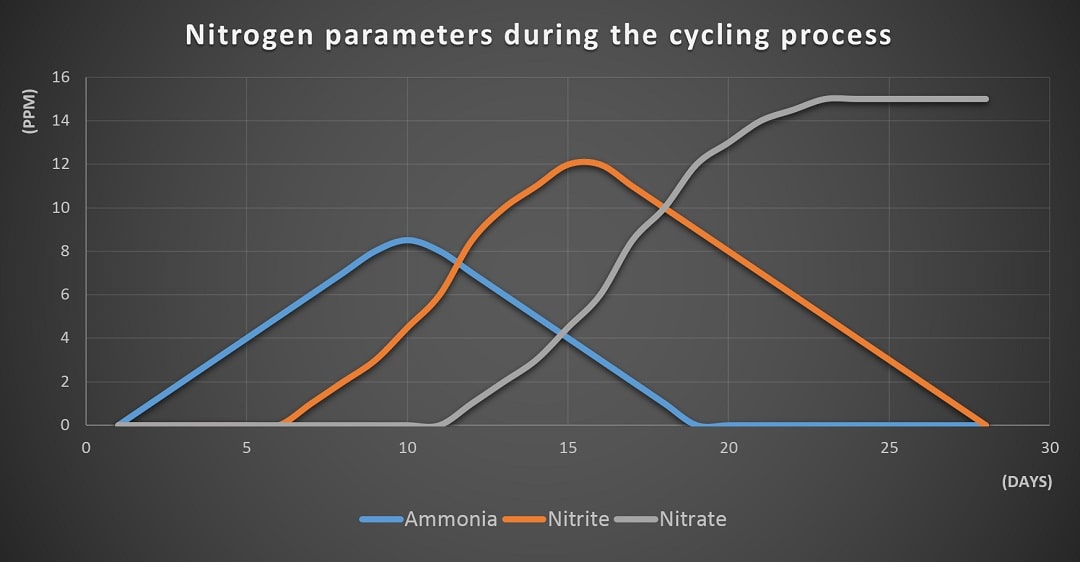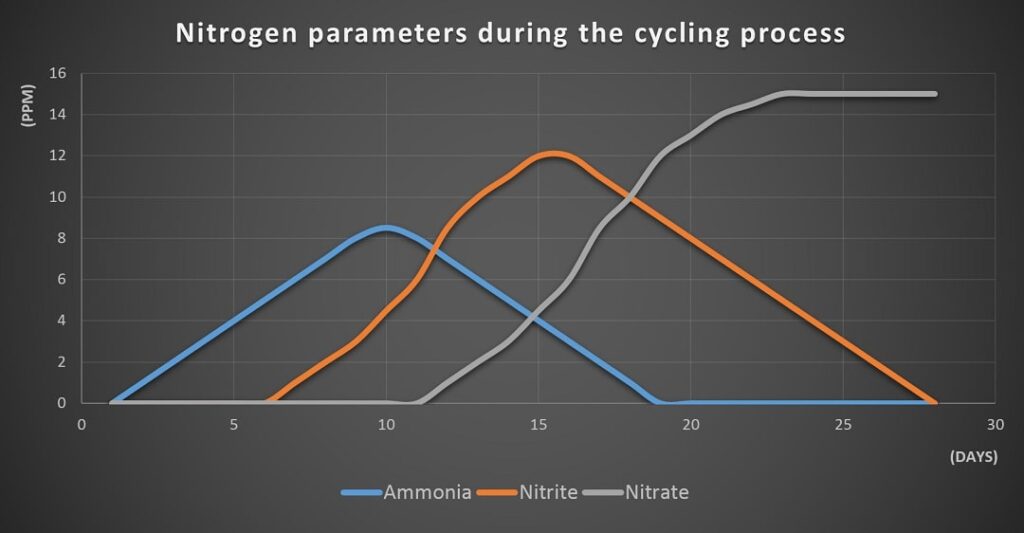Starting an aquaponics system requires to grow a bacteria population. We call this action “cycling the system” because the bacteria will complete the nitrogen cycle. The most common way to cycle an aquaponics system is to add a handful of fish food into the fish tank. Then, it is just a question of time for the bacteria to grow naturally. The cycling process generally takes around 30 days. During the aquaponics cycling process, we observe a peak of ammonia and nitrite. Both of those are very toxic for the fish. Hence, it is safer to cycle the system without fish and to add them after 30 days only. It is also good practice to wait 20 days before adding the plants. At this stage, the nitrate concentration (plant nutrient) start to raise.
Here are the points that we will develop:
- What is aquaponics cycling
- How do you start an aquaponics system
- Cycling techniques
- The good quantity of fish food for a fishless cycle
- How to check the cycling process
- When to introduce the fish
- Common mistake to avoid
- How long does it take to cycle an aquaponics system
- Tricks to boost the aquaponics cycling process
What is aquaponics cycling?
An aquaponics system is composed of a multitude of living creatures. Among them, bacteria have a key role. They transform the fish waste into plant nutrients. When we start an aquaponics system, the bacteria are not present in quality and quantity on the media. Cycling consist of growing those bacteria responsible for the Nitrogen cycle at the surface of the aquaponics media. In a flood and drain aquaponics system, this media is present into the grow-bed.
How do you start an aquaponics system?
Bacteria are present on all surfaces. some are even growing on and in yourself. Hence, bacteria are already present on the media that we add in our grow-bed. However, the specific type of bacteria that we need may be present but at a very low density. The aim is therefore to increase this population of bacteria (cycling the system). In order to succeed here, we first need to understand what is required for a good bacteria growth:
Bacteria needs
pH, moisture and temperature
Each species of bacteria has specific needs when it comes to pH, moisture and temperature. In aquaponics we are growing bacteria responsible for the nitrification. Those bacteria are more active at high pH (8 being perfect), high moisture level and a higher temperature. However, in aquaponics we work with an ecosystem. Hence, we tend to keep the pH around 7 which is completely acceptable for the bacteria. Moisture is highly present in aquaponics. The temperature is often an uncontrolled factor. The colder the temperature and the longer the cycling process will be.
The specific bacteria we are growing in aquaponics also have the 3 needs below:
Surface
Bacteria need a surface to live on. Hence, we choose a media offering a very large surface per volume. We talk about “Surface area“. small media offers a larger surface area than large media. It actually makes sense. Let’s say we have a large rock, the surface area of this rock will be the external surface. Now, if we take this same rock and break it in two rocks, we have created two new faces which increase the surface area.
An other factor increasing the media surface area is the porosity. On a plain rock, the bacteria can only grow on the surface. On a porous rock, bacteria can also grow inside. You will find more information in this video about aquaponics media. The point here is that bacteria need surface to grow on.
Nutrient
Like any living creature, bacteria need food to grow. In aquaponics we are growing two known species of bacteria:
The first bacteria is “Nitrosomonas“. This bacteria is digesting ammonia (fish waste) and releases nitrite.
The second bacteria is “Nitrobacter“. Nitrobacter consumes nitrite and release nitrate into the water. Nitrate is the source of nutrients for the plants. You will find more infomation on the nitrogen cycle here.
Hence, we understand here that we need ammonia in the water to initiate bacteria growth.
Oxygen
In aquaponics, we want to grow “aerobic” bacteria. In other words, bacteria who need to breath oxygen. Hence, we must make sure the aquaponics system supplies enough aeration to the bacteria. In a flood and drain aquaponics system, the bell syphon ensures the bacteria aeration. In a deep water culture, air stones linked to an air pump supply a constant aeration.
Cycling techniques
Now we understand that we need the above prerequisites to start the aquaponics system. But a question remain, how to supply ammonia into the system?
Cycling with fish
In a running aquaponics system, the fish consume fish food and release ammonia. Therefore, it would make sense to add fish and wait for the bacteria to grow. But! As we have seen before, during the cycling process, we have 2 peaks of toxicity. One peak of ammonia and one peak of Nitrite. Hence, adding fish since day zero could be fatal.
That said, I know how excited you are to start your aquaponics system. You probably can’t wait to add the fish and a month of cycling seems like a very long time. One option is to use hardy fish who can handle high concentration of ammonia and nitrite. Fish such as goldfish are often used to cycle the aquaponics system. If they often make it through the 2 peaks of toxicity, it’s not very nice for them to go through this exercise.
Cycling without fish
This cycling method is the best approach if you highly respect the fish health. We call fish-less cycle or cycling without fish. In this case, we still need to add a source of ammonia into the system. Below are different options:
Fish food
You can add a handle of fish food to your fish tank. The fish pellet will slowly break down and release ammonia into the water. This method is the best in my view. The ammonia released has the same profile as what your future fish will release. Hence, the growing bacteria will be well adapted to consuming fish waste. We find some alternative to this technique using cat food or dog food. Those options are also giving good results.
Pee
Pee is a good source of urea which contains ammonia. However, I am not sure your family will enjoy this practice. more information on this article about “pee in aquaponics”
Animals poop
Animal poop is an alternative to fish waste or fish food. The inconvenient is that warm animal poop sometimes carry pathogens. more information on this article about “aquaponics without fish”
Seasol
Seasol is a seaweed extract liquid often used in gardening. those products can be useful as long as they contain ammonia. However, it is frequent to find plant fertilizer rich in nitrate and poor in ammonia. A nitrate solution will not feed the bacteria. Hence, it will not help the cycling process.
pure ammonia
Pure ammonia can be efficient but it is a dangerous substance. I don’t recommend using it, Fish food is a better and safer alternative.
Quantity of fish food for a fishless cycle
I generally recommend a little handful of media for a system of 1000L. This quantity is not that important to be honest. Bacteria are able to double in population very quickly. Clostidium botulinum placed in good conditions can double in quantity every 20 minutes. Hence, we simply want to have a large population of bacteria. Then the population will adapt to the future quantity of fish very quickly. Hence, an approximate quantity of 80g per 1000L is enough.
How to check the cycling process?
There is no convenient way to measure the density and quality of bacteria present in a growbed. Indeed, we can’t see bacteria with our bare eyes. It would require a microscope and the density would necessitate dilutions and culture as practiced in laboratories.
Instead, we measure the water parameters. Their evolution is the best way to detect the presence of bacteria. During the cycling process we will measure the water every 2 days. We check the 3 following parameters: Ammonia, Nitrite and Nitrate.
Ammonia
Ammonia will slowly increase as the fish food is breaking down. Then, the bacteria will grow and consume the ammonia, hence, it will decrease.
Nitrite
Nitrite is appearing after the ammonia. It increase as the bacteria “Nitrosomonas” consume the ammonia. Then, the “Nitrobacter” bacteria consume the nitrite and the concentration decrease.
Nitrate
Nitrate is the last component to appear during the cycling process. it is the result of the transformation of the toxic elements that are ammonia and nitrite. When you see the apparition of nitrate, it is time to add the plants.
When to introduce the fish?
You can introduce the fish once the 2 peaks of ammonia and nitrite are gone and the values are back to zero.
When to introduce the plants?
Many beginners like to introduce the plants at the beginning. However, the best practice is to wait apparition of nitrate before planting your grow-bed. More information on aquaponics plants here
Common mistake to avoid:
Some beginners test the water at the very beginning and don’t detect ammonia and nitrite. Hence, they think the water is good and they introduce the fish. It is a mistake, at the beginning the water is OK because the fish food didn’t have time to release the ammonia. As a result, the bacteria haven’t grown and the 2 peaks of toxicity are to come…
How long does it take to cycle an aquaponics system?
We usually say that it takes a month to cycle an aquaponics system. However, several factors are influencing the bacteria growth. hence, it is better to track the water parameters than assuming that 30 days of aquaponics cycling will apply to you. The cycling time is mainly influenced by the water pH and temperature. The optimal being a pH around 8 and a temperature between 27 to 30C.
Tricks to boost the aquaponics cycling process
There are ways to boost this process. The main idea here is to start with a preexisting bacteria population. Let’s be clear, this step is not mandatory, it’s just a possibility to increase the aquaponics cycling speed. Here are different methods:
compost or worm casting
The compost and worm casting are very rich in bacteria and are good aquaponics cycling starters. Those bacteria are responsible for transforming organic matters into nitrate. They are the same bacteria as the ones needed in aquaponics. Hence, adding a handful of worm casting to your media will help and reduce the cycling time.
media from another system
Adding media from another established aquaponics system is a good trick. However, be careful as this practice contains risks. If this system is experiencing pest or disease, chances are that you will spread those with the media. You could therefore contaminate your new aquaponics system…
Bacteria mix sold in aquarium shop
Bacteria mix can be a good option to start your bacteria on the right foot. Spread the liquid on your media to start the process.
You now have enough information to launch your aquaponics system on the right foot. However, are you sure to know all the ratio and limits to build and manage an aquaponics system in the best way? Get my six steps to build and manage an Aquaponics system. Click here to access for free! Thanks and good reading 🙂



